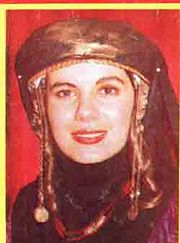Kafr Buhum
|
كفر بهم / Kafr Buhum Kafr Buhum |
||
|---|---|---|
|
|
||
| Coordinates | 35 ° 4 ′ N , 36 ° 42 ′ E | |
| Basic data | ||
| Country | Syria | |
| Hama | ||
| ISO 3166-2 | SY-HM | |
| height | 335 m | |
| Residents | 17,379 (2006) | |
|
City center
|
||
Kafr Buhum ( Arabic كفر بهم, DMG Kafr Buhum , Syrian : ܟܟܦܪ ܒܚܡ , transcription: Kafar Bouhoum ) is a small town in central Syria near the provincial capital Hama with a high Christian minority. The place has over 17,300 inhabitants.
Surname
The first part of the name, Kafr can mean “farm” or “village” in Syrian , Buhum (plural) “rock”, “strong man”. Kafr Abu , on the other hand, means "big house" in Syriac.
Kafr Ebham : Ebham stands for the word "thumb". This name refers to the thumb relic of Saint George , which is kept in a small tomb in the church. The city's first monastery, the Georgskloster, was built on this grave .
During the temporary union of Syria and Egypt from 1958 to 1961, Kfar Buhum was officially called "Al-Ghassanieah". However, the residents continued to use the old name. At the moment, all residents of the city tend to use the abbreviation "Kfarbou".
Geographical location
Kafr Buhum is located nine kilometers southwest of the city of Hama on a hill 351 m above sea level, 210 km north of Damascus and 160 km south of Aleppo . The city is oriented towards the Orontes Valley.
The nutrient-rich soils around Kafr Buhum and the field irrigation through groundwater wells ensure a high agricultural yield. In the north of the city there are limestone quarries, where 8 percent of the city's residents work. The mined rock is processed in modern factories and used to build houses.
history
More than 2000 years ago, Syrians and Arameans from surrounding regions settled in the area of today's old town. A visible testimony to this era is the Marienkirche and the icons of the various churches.
climate
Kafr Buhum has a Mediterranean climate. In winter it is cold and rainy, in summer it is warm and dry.
Due to its geographical location - surrounded by mountains, wide landscapes and the proximity to the Mediterranean Sea (80 km) - Kafr Buhum with its mild summer nights belongs to the climatically temperate areas of Syria. The annual mean temperature is 18.3 ° C, during the growing season 16.9 ° C, the average rainfall is 330 mm, of which 307 mm during the growing season. The number of midsummer days with over 30 ° is an average of 60 days per year. Thunderstorms occur on an average of 10 to 20 days, snowfall on one to four days, and there has not been a closed snow cover for many years. The wind blows mainly from the southwest and northeast. The number of hours of sunshine is above average in the summer half-year and below average in winter due to frequent inversion weather conditions. Kafr Buhum is a vacation spot.
Population development
According to statistics (2006), the city's population is over 17,379.
| year | Residents |
|---|---|
| 1922 | circa 1453 |
| 1960 | circa 3442 |
| 1970 | approx. 6120 |
| 1986 | approx. 8509 |
| 1990 | approx. 10.112 |
| 2000 | approximately 14,368 |
| 2007 | approximately 17,379 |
education
Kafr Buhum has a larger catchment area through general and vocational schools. There are three private kindergartens; six state schools take students to university entrance qualification. In addition, there are a number of vocational schools. The new generation has a high proportion of academics. A growing proportion of university graduates (doctors, engineers, lawyers, etc.) have emigrated mainly to the Gulf States and Europe.
economy
Most of the city's residents make a living from agriculture and industry. Mainly corn, cotton, potatoes, olives, white and red beets are grown on the agricultural areas around the city. Country estates are passed on from generation to generation.
Artisanal shops are common in the streets of the city, but these are now threatened by the construction of an industrial area, to which the shops in the city center will have to move as soon as construction is finished.
Music and entertainment
Folk music, poetry and prose arts are very important in the city; own traditions at weddings and official holidays are maintained. The city holds small carnival festivals every year, the most important of which is the Albaaoth Monday carnival (Easter Monday). All classes of the population and associations take part in this carnival, which is organized by over 400 children. Religious and social private festivals are celebrated in the restaurants. Great emphasis is placed on folk music Alataaba wa Almejana .
Buildings
Traditional buildings are made of white limestone blocks. The great Cathedral of Saint Elias has been built since 1993, financed only by the residents of the city. Construction work was expected to be completed in 2008.
Personalities
- Gregoris bin Fadel : The first Roman bishop in Aleppo between 1540 and 1582
- Agnatios Attieah : Patriarch of Antakia for seven years until his death in 1635.
- Makarios Alzaaim : Patriarch of Damascus from 1647 until his death in 1672.


